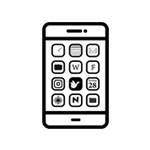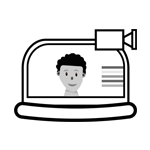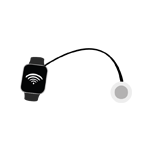Search the Database
Use the filters in the drop-down menus below to search the article database.
Icon guide
The results are visualised with a colour system (grey, green, yellow and red), where green indicates a statistically significant improvement of clinical effects, patient experience or a statistically significant reduction of expenses in one or more health services (economic effects).
The table provides a link to information about each article including the Pubmed ID and link to the full text article.
Technology

App

Video consultation

Phone consultation

Home monitoring

SMS / Mail

Website
Clinical Effect, Patient Experience, Economic Effect
- No information
- Positive effect
- No effect
- Negative effect
Implementation
- Requires cross-sector collaboration
- Requires new equipment
- Requires additional development
- Requires new skills, training or new tasks
- Is addition to usual treatment
- Requires integration with electronic patient record
| Title | Country | Diagnosis | Intervention | Technology | Clinical Effect | Patient Experience | Economic Effect | Implementation | |
| Does Telephone Follow-Up and Education Affect Self-Care and Metabolic Control in Diabetic Patients? | Turkey | Diabetes mellitus; diagnosed in the previous year. | Patient education at the hospital in groups. Telephone follow up: 1 call every week/first month, 1 call every second week/second and third month. Review of metabolic values and continuous education |
D | Read more | ||||
| Effects of care management and telehealth: a longitudinal analysis using medicare data. | USA | Diabetes mellitus | Health buddy collect patient information on symptoms, vital signs, mental health, knowledge, and health behaviors by daily questions. Data were risk stratified for identification of appropriate feedback and intervention from care providers. |
B+D | Read more | ||||
| Home Telemedicine (CoYoT1 Clinic): A Novel Approach to Improve Psychosocial Outcomes in Young Adults With Diabetes. | USA | Diabetes (type 1) Age 18-25 years | Complete 3 telemedicine appointments (with care provider only or a group session) and 1 in person visit. |
B+D | Read more | ||||
| A randomised, controlled trial of the effects of a mobile telehealth intervention on clinical and patient-reported outcomes in people with poorly controlled diabetes. | UK | Diabetes type 1 or 2 Hba1c>7.5% | Data on BP and BG recorded and stored by patients. Nurse accessed data via web and provided feedback on the clinical readings (as needed) and education on lifestyle changes (six weekly calls). |
B+D | Read more | ||||
| Investigating the behavioural effects of a mobile-phone based home telehealth intervention in people with insulin-requiring diabetes: Results of a randomized controlled trial with patient interviews. | UK | Diabetes type 1 or 2 Hba1c>7.5% | Data on BP and BG recorded and stored by patients. Nurse accessed data via web and provided feedback on the clinical readings (as needed) and education on lifestyle changes (six weekly calls). |
B+D | Read more | ||||
| Teleconsultation in type 1 diabetes mellitus (TELEDIABE). | Italy | Diabetes 1, 5-50 years old | Teleconsultation via web with a diabetologist every 4th month. Before consultation patients send glycemic profiles via email. During teleconsultations general condition is discussed, clinical data analyzed evaluation of therapy, plan follow up. |
B+D | Read more | ||||
| A prospective randomized trial examining health care utilization in individuals using multiple smartphone-enabled biosensors. | USA | One of three study conditions: hypertension, diabetes and/or cardiac arrhythmia | Patients asked to take readings on BP and BG. Data uploaded to app available for nurses. If poor monitor compliance nurses would send a reminder (email). |
C+D | Read more | ||||
| Personalised telehealth intervention for chronic disease management: A pilot randomised controlled trial. | Australia | Diabetes and/or chronic obstructive pulmonary disease (COPD) - high risk for readmission | Patients collect data on BP and BG and enter daily answers to health questionnaire on online platform. Nurses identify when data are outside threshold and respond to pt. |
A+B+C | Read more | ||||
| Sugarsquare, a Web-Based Patient Portal for Parents of a Child With Type 1 Diabetes: Multicenter Randomized Controlled Feasibility Trial. | Netherland | Parents of children with T1D below the age of 13 years | Sugarsquare, a web-based patient portal providing online parent-professional communication, peer support, and disease information. |
C+D+E | Read more | ||||
| TECNOB Study: Ad Interim Results of a Randomized Controlled Trial of a Multidisciplinary Telecare Intervention for Obese Patients with Type-2 Diabetes. | Italy | Obesity (BMI ≥30), Diabetes type 2 | Patients use the TECNOB web platform for monitoring data concerning dietary, activity level, weight and glycated hemoglobin. Patients maintain contact with dietitian and psychologist via SMS (regularly) and videoconference |
B+C+D | Read more | ||||
| Testing a Smartphone App (Young with Diabetes) to Improve Self-Management of Diabetes Over 12 Months: Randomized Controlled Trial. | Denmark | Diabetes type 1, 14-22 years old, HbA1c ≥64 mmol/mol (8%) at last visit | The mhealth app provides a platform for young people to access information and support from peers, parents, and health care providers. |
C+D+E | Read more | ||||
| The Diabeo software enabling individualized insulin dose adjustments combined with telemedicine support improves HbA1c in poorly controlled type 1 diabetic patients: a 6-month, randomized, open-label, parallel-group, multicenter trial (TeleDiab 1 Study). | France | Diabetes type 1; HbA1c ≥ 8.0% | App monitoring BG and physical activity. Phone call every 2 week. Teleconsultations focused on insulin dose adjustments and motivational support. |
C+D | Read more | ||||
| One-year efficacy and safety of the telehealth system in poorly controlled type 2 diabetic patients receiving insulin therapy. | Taiwan | Diabetes type 1 + 2; HbA1c > 7.5 or identified as not well controlled | Patients upload daily data on BG, BP and HR. Caregivers can also enter the system and provide information and support. Automatic message to care providers when the data exceeds alerting range and care giver contacts the patient |
B+D+E | Read more | ||||
| An Internet-based health gateway device for interactive communication and automatic data uploading: Clinical efficacy for type 2 diabetes in a multi-centre trial. | Southkorea | Diabetes 2 for more than one year | Patients upload data on BG to online server. Nurses monitor the patient system, review patient information, and send optimized recommendations to patients via the device’s electronic chart system. |
B+D | Read more | ||||
| Telemonitoring of Type 2 Diabetes Mellitus in Italy. | Italy | Diabetes type2, HbA1c > 53mmol/mol (7.0%) | Patients monitored and transmitted data on BG to an eHealth portal. Clinicians access the portal any time and were informed when anomalies were detected, to take appropriate action. |
B+D | Read more | ||||
| Cost-benefit analysis of internet therapeutic intervention on patients with diabetes. | Canada | Patients with diabetes reporting blood glucose online | Patients upload data on blood glucose on online platform. Endocrinologists review the reports and send feedback directly to the patients via email. Recommendations included: medication adjustments, suggestions on testing frequency and lifestyle modifications. |
B+D | Read more | ||||
| The efficiency of telemedicine to optimize metabolic control in patients with type 1 diabetes mellitus: Telemed study. | Spain | Diagnosed with type 1 diabetes at least 5 years previously; 18–55 years; HbA1c >8% | Patients carry out three self-monitoring of blood glucose tests per day and opload data once a month following response from diabetes team via telephone |
C+D | Read more | ||||
| Validity Study of Video Teleconsultation for the Management of Diabetes: A Pilot Randomized Controlled Trial. | Australia | Diabetes type 1 +2 | To evaluate the agreement of prescription decisions of endocrinologist between videoconferencing and in person consultation. One in person consultation and one video consultation. |
B+D | Read more | ||||
| Impact and duration effect of telemonitoring on ΗbA1c, BMI and cost in insulin-treated Diabetes Mellitus patients with inadequate glycemic control: A randomized controlled study. | Greece | Diabetes type 1 +2 | Pt. transmits data on BG every day. An endocrinologist reviewed the data and contacted participants via SMS or e-mails when necessary. |
B+D | Read more | ||||
| Video consultations as add-on to standard care among patients with type 2 diabetes not responding to standard regimens: a randomized controlled trial. | Denmark | Diabetes type 2; HbA1c>7.5%; BMI >25 kg/m2 | Monthly video conferences with a nurse. Patients upload measurements on blood sugar, blood pressure, and weight regularly. |
B+D+E | Read more | ||||
| Utilization of a Cloud-Based Diabetes Management Program for Insulin Initiation and Titration Enables Collaborative Decision Making Between Healthcare Providers and Patients. | USA | Diabetes type 2; HbA1c levels of 9-14% | Homemonitoring of blood glucose. Virtual interactions (messaging and video/voice communication on regular basis as needed. |
B+D | Read more | ||||
| Smart Care Based on Telemonitoring and Telemedicine for Type 2 Diabetes Care: Multi-Center Randomized Controlled Trial. | South Korea | Diabetes type 2; HbA1c ranging from 7-11% | Patient performs measures on blood glucose and weight by using home monitoring equipment. Reports to endocrinologist after 8, 16, 24 weeks on scheduled outpatient appointment. Instead of outpatient visits on hospital, patients contacted physicians via video consultations using the web software. |
B+D | Read more | ||||
| Efficacy of the Telemedical Lifestyle intervention Program TeLiPro in Advanced Stages of Type 2 Diabetes: A Randomized Controlled Trial. | Germany | Diabetes type 2; Overweight or obese | Patients monitor and transfer their data on blood glucose, weight and numbers of daily steps via TeLiPro device. Diabetes coaches calls patient weekly for discussion of measured data and for diabetes relevant information |
B+D | Read more | ||||
| Randomized, Open-Label, Parallel Group Study to Evaluate the Effect of Internet-Based Glucose Management System on Subjects with Diabetes in China. | China | Diagnosed with diabetes for over 1 year; HbA1c levels of 7.0–10.0% | Blood sugar monitoring through webpage. Visit on hospital every 3 months. Changes in blood sugar levels visible, and possible to receive messages via weppage. First 3 months, the nurses provided recommendations regarding blood sugar control on a weekly basis, and then biweekly recommendations were provided for the remaining 3 months |
C+D | Read more | ||||
| An Intervention by a Patient-Designed Do-It-Yourself Mobile Device App Reduces HbA1c in Children and Adolescents with Type 1 Diabetes: A Randomized Double-Crossover Study. | Switzerland | Age 10-18 years Type 1 diabetes | Patients created an account on the app which allows for remote access to blood glucose data by both patient and diabetology team. Blood glucose values were reviewed every month by the diabetologists and suggestions for treatment adaptation were sent to the participants by e-mail. |
C+D | Read more | ||||
| Type 2 diabetes specialty clinic model for the accountable care organization era. | USA | Type 2 diabetes; A1C≥8.0% and ≤ 11.0%; treated with ≥ 3 medications for diabetes | The pre-planned disease interventions were done via emails or phone calls and modified as needed while seeing the patient once a year in the clinic. For example, a plan for a patient may have included 12 provider initiated email/phone calls per year to review recent glucose readings to adjust insulin therapy |
C+D | Read more | ||||
| Telemedicine diabetes consultations are cost-effective, and effects on essential diabetes treatment parameters are similar to conventional treatment: 7-year results from the Svendborg Telemedicine Diabetes Project. | Denmark | Min 6 month of telemedicine diabetes control | Audiovisual contact between physician situated in his office at mainland (Svendborg) and patient + nurse situated in a clinic on the island Aeroe. Standard diabetes parameters evaluated. |
B+D | Read more | ||||
| The Mobile Insulin Titration Intervention (MITI) for Insulin Adjustment in an Urban, Low-Income Population: Randomized Controlled Trial. | USA | Patients requiring insulin glargine titration; HbA1c ≥ 8% | Pt responds daily text messaging with their blood glucose value. Diabetes nurse monitor the values and call patient if values are alarming. Patients call nurse if needed. The nurse reviewed values once a week to adjust the insulin dose |
C+D | Read more | ||||
| Shared care combined with telecare improves glycemic control of diabetic patients in a rural underserved community. | Taiwan | Diabetes 2; HbA1c > 7% | Six diabetes sessions, one to start the electronic glucose home management system followed by three internet education sessions. Last two sessions conducted by a shared care team (nurse, dietitian and diabetic specialist) by interactive videoconference with patient and his/her primary physician. |
A+B+C+D | Read more | ||||
| A multimodal blood pressure control intervention in 3 healthcare systems. | USA | Hypertension with 4 or fewer antihypertensive medications, Elevation in 2/3 recent BP measurements | Home BP monitoring 3-4 times/ week. Reporting data on BP data once a week via IVR phone system. Possible to listen to educational message or request call from pharmacist. Phone call from pharmacist discussing changes in medication, lifestyle |
B+C+D+E | Read more | ||||
| Cellular phone and Internet-based individual intervention on blood pressure and obesity in obese patients with hypertension. | South Korea | Hypertension (BP> 120/80mmHg); Obesity (BMI>21 kg/m2) | Patients upload clinical data on BP and weight to webpage. Health provider view information and conduct recommendations for patients via internet or SMS. Recommendations consisted of continuous education on diet, exercise, medication adjustment, and bodyweight levels. All medication adjustments were communicated to the patients’ doctor. |
A+C+D | Read more | ||||
| Evaluation of mobile phone and Internet intervention on waist circumference and blood pressure in post-menopausal women with abdominal obesity. | South Korea | Women with abdominal obesity (WC>80 cm) | Patients upload clinical data on Bp and weight to webpage. Health provider view information and conducted recommendations for patients via internet or SMS. Staff provided 3 sms/week, greetings on the new week on Monday and encourage of life style modification on Wednesday. Friday individualized recommendations to the patient based on clinical data. |
C+D | Read more | ||||
| Telemedicine compared with standard care in type 2 diabetes mellitus: A randomized trial in an outpatient clinic. | Denmark | Type 2 diabetes; 40-85 years | Homemonitoring with blood pressure monitor. Video consultation with a nurse. A Doctor was sometimes present or asked for advice during consultations. The patient returned to their general practitioner after stabilization typical after 3 weeks. |
D | Read more | ||||
| CoYoT1 Clinic: Home Telemedicine Increases Young Adult Engagement in Diabetes Care. | USA | Diabetes type 1; Age 18-25 years | Patients completed 3 telemedicine visits and one in-person appointment with care provider. Before appointment pt. upload data on blood glucose. During telehealth visit care provider reviewed clinical data and discussed barriers to individual diabetes management. As a part of teleconsultations online group sessions were held consisting of four patients |
B+D | Read more | ||||
| Mobile Phone-Based Telemedicine Practice in Older Chinese Patients with Type 2 Diabetes Mellitus: Randomized Controlled Trial. | China | Older than 65 years; HbA1C level 7-10% | Patients upload data on blood glucose via app. Medical team send medical advice and reminders via app or SMS every 2 weeks. Once monthly dietary recommendations were sent. Follow up in clinic at 3 months interval |
B+C+D | Read more | ||||
| The cost-effectiveness of hospital-based telephone coaching for people with type 2 diabetes: a 10 year modelling analysis. | Australia | Diabetes type 2 HbA1C greater than 7% | Diabetes coaching defined as regular provision of telephone advice and coaching that address lifestyle modification and adherence to treatment |
- | Read more | ||||
| Telemedicine-Assisted Self-Management Program for Type 2 Diabetes Patients. | Germany | Diabetes type 2; Age 40-67 years | Homemonitoring with glucometer and step counter. Tele medical devices served as a feedback tool for the patients to provide insight into the impact of behavior changes on their blood glucose levels. In each phone-based meeting, coach and participant developed and agreed on personal health goals that helped to better control the disease step by step. Phone calls at least every month. |
B+D+E | Read more | ||||
| Cost-effectiveness of Shared Telemedicine Appointments in Young Adults With T1D: CoYoT1 Trial. | USA | Diabetes type 1; Age 18-25 years | Patients completed 3 telemedicine visits and one in-person appointment with care provider. Before appointment pt. upload data on blood glucose. During telehealth visit care provider reviewed clinical data and discussed barriers to individual diabetes management. As a part of teleconsultations online group sessions were held consisting of four patients |
B+D | Read more | ||||
| Telemedicine in the Management of Type 2 Diabetes Mellitus. | China | Type 2 diabetes; HbA1c 7-10.0% | Patients upload data on blood glucose to website 2 times a day, 2-3 days/week. Medical team log on to the website every 2 week to analyze data and to deliver advice to the patient leaving messages on the website or via telephone. |
B+C+D | Read more | ||||
| Effects of continuous care for patients with type 2 diabetes using mobile health application: A randomised controlled trial. | China | Diabetes type 2; Aged 30-60 years; HbA1c greater than 7.0% | Daily blood glucose and lifestyle monitoring via the health app. Recommendations on dietary and exercise based on records were provided in the app weekly. Nurses followed up once a week after discharge for 3 months and then once a month on the mobile service platform when the patient’s blood sugar level was stable. |
C+D | Read more | ||||
| Cardiac-diabetes self-management program for Australians and Taiwanese: A randomized blocked design study. | Australia and Taiwan | Acute coronary syndrome, Diabetes type 2 | Personal 30-40 min telephone call (1 week post discharge), 2 SMS (1 per week post telephone follow-up). Assist patients in problem-solving approaches and monitoring their diet, physical activity, medications and blood glucose levels. |
D+E | Read more | ||||
| A randomized controlled trial comparing a telemedicine therapeutic intervention with routine care in adults with type 1 diabetes mellitus treated by insulin pumps. | Israel | Diabetes type 1 treated with insulin pump; Age > 22 years | Patients download and transmit data on blood glucose once a month. Physicians review data and document recommendations. Study coordinator informed patients about updated recommendations via phone call. Face to face visits in clinic once in 6 months. |
B+C+D | Read more | ||||
| Web-based telemedicine for management of type 2 diabetes through glucose uploads: a randomized controlled trial. | China | Type 2 diabetes | Patients taught to use telemedicine software to upload their blood glucose, weight and blood pressure at home at least every 2 weeks. Staffs read and analyze the data, and then give guidance to the patients through internet, short messages, or tele¬phone. |
B+D | Read more | ||||
| A case management intervention targeted to reduce healthcare consumption for frequent Emergency Department visitors: results from an adaptive randomized trial. | Sweden | Frequent emergency department visitors. | Patient and nurse meet for interview of patient’s medical and social history. Followed by telephone contact made on a regular basis. Nurses facilitated contacts with healthcare providers, coached patients’ disease self-management, and supported interactions with social services. |
D+E | Read more | ||||
| Cognitive and physical rehabilitation of intensive care unit survivors: results of the RETURN randomized controlled pilot investigation. | USA | Intensive care unit survivors. | 12 visits – 6 in person visits for cognitive rehabilitation and 6 videoconference with 2 ways videophones for physical and functional rehabilitation, each 60-75 minutes in length. Visits were supplemented with brief telephone calls during alternate weeks. Participants completed a workbook between visits to help track compliance. |
B+D+E | Read more | ||||
| Randomized controlled pilot study of an educational video plus telecare for the early outpatient management of musculoskeletal pain among older emergency department patients. | USA | Emergency department visitors with musculoskeletal pain > 50 years | Interactive educational video material. A telephone call at 48–72 hours after discharge from ED, scripted to support shared decision-making to identify changes in medications and behaviors to promote recovery. |
C | Read more | ||||
| A randomized trial to evaluate the efficacy of online follow-up visits in the management of acne. | USA | Mild to moderate acne ≥12 years | Patients upload 3 facial digital images to a secure website and complete a structured set of disease-specific questions online. The e-visit platform allowed physicians to modify treatments, clarify the history, and attach electronic prescriptions. |
C+D | Read more | ||||
| Web-based telemedicine system is useful for monitoring glucose control in pregnant women with diabetes. | Spain | Diabetes before or during pregnancy. | Glucose control was evaluated every 2 weeks on a Web-based telemedicine system called ‘‘DiabeTIC’’ with feedback by email or phone message. |
B+C+D | Read more | ||||
| Using Smartphone-Based Psychoeducation to Reduce Postnatal Depression Among First-Time Mothers: Randomized Controlled Trial. | Hong Kong | First time mothers. | Patients were provided access to iParent app after first visit to antenatal clinic. App provided education and information + a platform for communication with healthcare professionals. |
B+C+D+E | Read more | ||||
| Internet delivered cognitive behavior therapy for antenatal depression: A randomised controlled trial. | Sweden | Pregnant 10>28 weeks, meeting diagnostic criteria for major depression. | Reading material, assessments, homework and work-sheets were delivered via a secure online platform. Patients also had a therapist providing regular feedback, encouragements and support in written messages. |
C+D+E | Read more |
